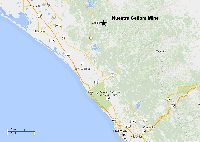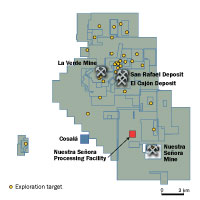Cosal´┐Ż Operations
| ´┐Ż | Overview | ||
| ´┐Ż | The Cosal´┐Ż mining district is located in the east-central portion of the state of Sinaloa, Mexico along the western edge of the Sierra Madre Occidental, an extensive tertiary volcanic province covering approximately 800,000 km2. It is accessible from the town of Cosal´┐Ż via rural paved and dirt roads. All primary access roads can accommodate standard highway vehicles. Mineralization in the Cosal´┐Ż district is related to granodioritic or granitic intrusions emplaced between 140 and 45 million years ago into Cretaceous sedimentary rocks that overlie older basement terranes. In 2015, production from the Cosal´┐Ż Operations totaled 1.16 million silver ounces and 2.40 million silver equivalent ounces at a cash cost of $10.80 per ounce and an all-in sustaining cost of $14.89 per ounce.  Location Map  Cosal´┐Ż Operations Map | ||
| ´┐Ż | |||
| ´┐Ż | San Rafael | ||
| ´┐Ż |
´┐Ż [1] The March 2016 Prefeasibility Study for the San Rafael Project adjusted for recent spot prices of $20.00 per ounce of silver, $1.01 per lbs. of zinc, $0.83 per lbs. of lead and 18.5:1 for the MXP:USD exchange rate. [2] Pre-Feasibility pre‐production capital reduced from $22M using current exchange rates. | ||
| ´┐Ż | |||
| ´┐Ż | Nuestra Se´┐Żora | ||
| ´┐Ż | Located in the Cosal´┐Ż district, Nuestra Se´┐Żora is a fully mechanized underground silver-zinc-lead-copper mine with the benefit of flexible mining methods and diversified metal production. With a processing facility nearby, the operation has a capacity of 1,600 tonnes per day and permitted capacity for expansion to 4,000 tonnes per day. The plant produces zinc, copper and lead concentrates, with a significant silver component in the copper and lead concentrates. Concentrates are delivered to purchasers in Manzanillo, Mexico. Geology Mineralization at the Nuestra Se´┐Żora mine occurs in four known deposits located within a 500m by 250m area - Nuestra Se´┐Żora, Candelaria, Santa Teresa and Santo Domingo - which were originally developed and exploited from 1954 to 1965 by Asarco. Carbonate replacement-style mantos, veins, chimneys, chimney breccias, and mineralized exoskarn and endoskarn occur within limestone and granodiorite. Pyrite, sphalerite, chalcopyrite, galena, and lesser tetrahedrite are the dominant sulfide minerals. | ||
| ´┐Ż | |||
| ´┐Ż | El Caj´┐Żn | ||
| ´┐Ż | El Caj´┐Żn has considerable development in place following approximately $10 million in capital spending over the past three years. Permits are in place and the portal was collared in March 2014. More than 1,000 meters of ramp and lateral development has been completed to-date to provide access to upper stopes. Given changes in metal prices, the company expects to be back in production in 2017. The mine will operate temporarily as we transition fully to San Rafael ore. | ||
| ´┐Ż | |||
| ´┐Ż | Other Projects | ||
| ´┐Ż |
La Estrella
The Estrella operation currently comprises the removal of existing historic dumps and concurrent mapping and sampling. The previous operators apparently removed only higher grade, copper-rich material by hand sorting. The rejected material was piled in dumps. This material has sufficient silver, zinc, lead and copper to be processed at the company's mill. An operation of sampling, stockpiling and hauling this material to the mill is on-going.´┐Ż
While removing the existing dumps an area of sulphide mineralization has been exposed in the walls of the existing workings. Company geologists are presently evaluating this showing to determine the deposit's potential grade and size.
La Verde
The La Verde area has been mined intermittently for over 10 years by a third-party operating under a royalty contract with the Company. While no historical drilling records or resource estimates are available, historical production data indicates that a consistent feed of approximately 120 grams per tonne silver and 0.3-0.5% copper was provided to a local processing plant. At the present time, the Company is focused on underground mapping and drilling to expand and better define known areas of mineralization.
| ||
| ´┐Ż |
Previous. All´┐Żpages. Next. 1. 2. 3. 4. 5
´┐ŻFurther reading
- Casino Non Aams
- Migliori Casino Online
- Casino Non Aams
- New Betting Sites UK
- Non Gamstop Casino
- Gambling Sites Not On Gamstop
- Bitcoin Casinos
- τα καλυτερα Online Casino
- Best Online Casino Canada
- Non Gamstop Casino Sites UK
- Slots Not On Gamstop
- Sites Not On Gamstop
- Meilleur Casino En Ligne
- Casino En Ligne
- Casinos Not On Gamstop
- UK Online Casinos Not On Gamstop
- UK Casino Not On Gamstop
- UK Online Slot Sites
- Online Casinos UK
- Meilleur Casino En Ligne France
- Non Gamstop Casino
- Casino Sites Not On Gamstop
- Lista Casino Non Aams
- Meilleur Casino En Ligne 2025
- Migliori Casino Non Aams
- Crypto Casinos
- Casino Crypto
- Siti Non Aams
- Meilleur Casino En Ligne
- Nouveau Casino En Ligne Fiable



